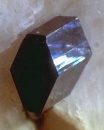
|
| Babingtonite |
Chemical
Formula |
Ca2(Fe,Mn)FeSi5O14(OH) |
Species |
Silicates |
Crystal
System |
Triclinic |
Mohs
Scale |
5-6 |
Specific
Gravity |
3.3 |
Color |
Dark green to black |
Luster |
Vitreous |
Refractive
Index |
n = 1.700 n = 1.710 n = 1.725 |
Diaphaneity |
Opaque |
Cleavage |
PerfectPerfect on Good on and |
Fracture |
Irregular/Uneven |
| Crystal Habit:Prismatic crystals |
| Geological Setting:Veins cutting granitic pegmatites and diorites, cavities and vugs in mafic volcanic rocks and gneisses, skarns. |
Babingtonite is a calcium iron manganese inosilicate mineral with the formula Ca
2(Fe,Mn)FeSi
5O
14(OH). It is unusual in that iron(III) completely replaces the aluminium so typical of silicate minerals. It is a very dark green to black translucent (in thin crystals or splinters) mineral crystallizing in the triclinic system with typically radial short prismatic clusters and druzy coatings. It occurs with zeolite minerals in cavities in volcanic rocks. Babingtonite contains both iron(II) and iron(III) and shows weak magnetism. It has a Mohs hardness of 5.5 to 6 and a specific gravity of 3.3.
It was first described in 1824 from samples from Arendal, Aust-Agder, Norway (which is its type locality) and was named after the Irish physician and mineralogist William Babington (1757–1833).
It is the official mineral (mineral emblem) of the Commonwealth of Massachusetts.


 YueGongAnBei 44051102000467
YueGongAnBei 44051102000467


 |
|